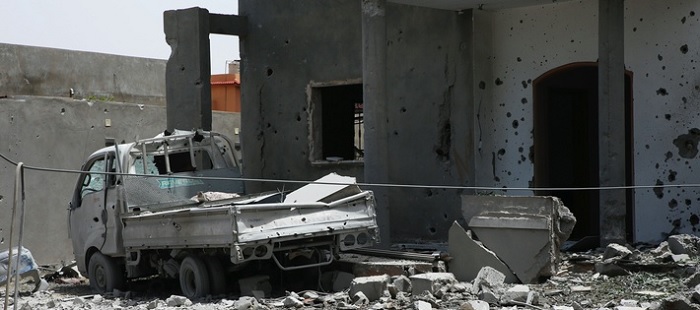
The Libyan conflict, now entering its ninth year, could well be a testing ground for how wars will be fought in the future. The conflict itself looks much different today than it did in 2011, when a coalition of NATO countries deposed longtime Libyan dictator Muammar Qaddafi and the country quickly descended into civil war and internecine fighting between tribal militias, Salafi jihadists, and other non-state actors.
On one side of the conflict is the internationally recognized Government of National Accord, or GNA, backed by Turkey and, to a lesser extent, Italy and Qatar. On the other side is the Libyan National Army, or LNA, led by the notorious warlord Khalifa Haftar and backed by a diverse coalition that includes Russia, the United Arab Emirates, and Egypt, with varying degrees of support from Saudi Arabia, France, and Greece. The stakes are high; the prizes include access to Libya’s vast energy reserves and contracts to extract, refine, and deliver them.
But external nation-states have long interfered in other countries’ civil wars, so what is new, exactly, about what is happening in Libya?
Both sides of the conflict are increasingly reliant on mercenaries. Turkey has trained and dispatched mercenaries from Syria to Libya, while Haftar’s forces have been boosted by the Wagner Group: Russian mercenaries who have been dispatched to Ukraine, Syria, Central African Republic, Sudan, Zimbabwe, Mozambique, and now Libya. Moreover, Russia is recruiting Syrian mercenaries of its own to deploy to Libya and fight on behalf of Haftar. The LNA has also teamed up with mercenaries from Sudan and Westerners working for private security contractors based in the United Arab Emirates.
When Haftar launched his bid to capture Tripoli in April 2019, the ensuing air operations from both sides involved small fleets of aged fighter jets. Since then, air strikes have been increasingly conducted by foreign drones: Turkish Bayraktar TB2s for the GNA and Emirati Wing Loong-IIs for Haftar. As Turkey and the UAE battled for air superiority, their interventions quickly escalated into what former UN Envoy to Libya Ghassan Salamé has suggested is the “largest drone war…in the world.” As of January, the UAE and Turkey had reportedly conducted upwards of 850 and 250 drone strikes, respectively.
As the disparity in strike totals suggests, the UAE achieved the upper hand, for a time. But Ankara has ratcheted up its military support since last November, when Turkey and the GNA signed security and maritime memorandums of understanding. Turkey began deploying more drones, advanced air defense systems, and thousands of Syrian mercenaries, swinging the balance of power back toward the Tripoli government. Turkey has since pounded Haftar’s forces with air strikes, destroying several Russian-made Pantsir S1 air defense systems and facilitating rapid advances by anti-Haftar forces. And just last month, Russia deployed fighter jets, likely piloted by mercenaries, to central Libya in a move to deter expanded Turkish air operations and stem the tide of Haftar’s reversals.
Disinformation efforts have also sought to tip the balance of power in Libya. While these efforts emanate from both sides of the conflict, the countries backing Haftar and the LNA—especially Russia, the UAE, and Saudi Arabia—have been more active and aggressive in deploying armies of bots, sock puppets, and trolls to peddle pro-Haftar messages. For instance, the Atlantic Council’s Digital Forensics Research Lab found that a pro-Haftar Arabic-language hashtag, “#WeSupportTheLibyanArabArmy,” was retweeted 20,000 times the day Haftar announced his offensive on Tripoli—the largest clusters of accounts coming from Egypt, the UAE, and Saudi Arabia.
In addition, the deployment of thousands of Syrian and Sudanese mercenaries to Libya reflects a growing and troubling trend in modern proxy warfare. State actors are increasingly exploiting stateless or at-risk populations to recruit fighters, whom they deploy abroad to project power. Iran deployed tens of thousands of stateless Hazara Afghans to fight for Bashar al-Assad’s regime in Syria, and Turkey, Russia, and the UAE are similarly deploying mercenaries drawn from desperate communities to fight in Libya’s civil war.
It is far more cost-effective for a country like Russia to do its bidding through private security contractors and social-media campaigns instead of deploying Russian troops and risking the backlash that would come both domestically and internationally. Given the restrictions of the coronavirus and the stress this will place on military budgets and national economies, the future of warfare could begin to look more and more like “wars on the cheap.”
At least in the immediate future, the notion of “wars of distance,” or fighting from afar, could become commonplace as a way for countries to insulate their soldiers from risk, both from conflict and disease. As a substitute for soldiers, we could see a trend developing that looks a lot like the model playing out in Libya: emerging technology coupled with proxy forces and social media campaigns.
 Eurasia Press & News
Eurasia Press & News



